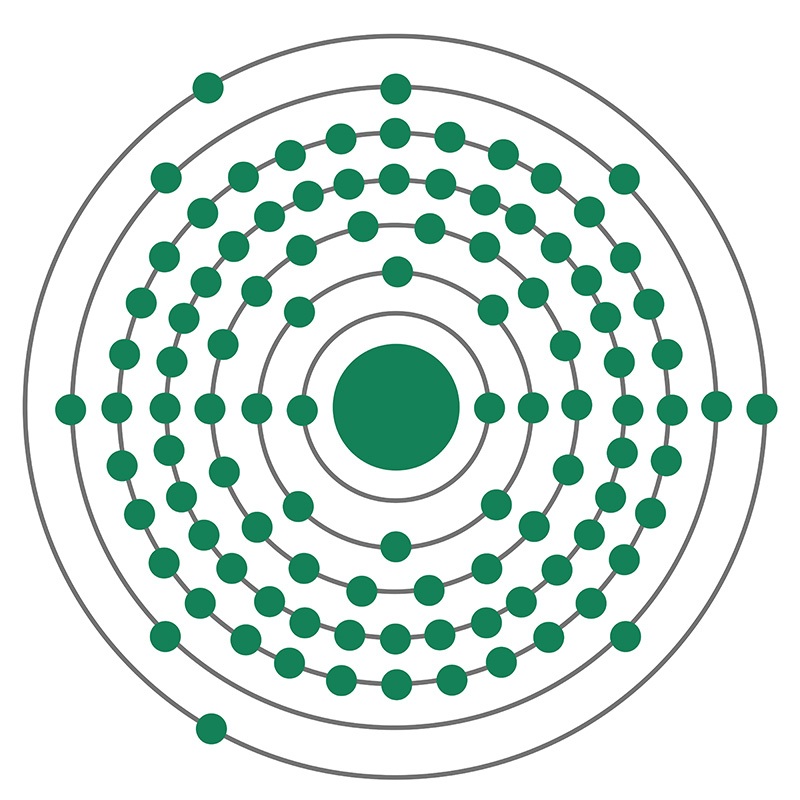Math Is Fun Forum
You are not logged in.
- Topics: Active | Unanswered
Pages: 1
#1 2025-10-16 16:01:50
- Jai Ganesh
- Administrator

- Registered: 2005-06-28
- Posts: 52,128
Lawrencium
Lawrencium
Gist
Lawrencium (Lr) is a synthetic, radioactive element with atomic number 103, belonging to the actinide series. It is a highly reactive metal that does not occur naturally and is only produced in tiny quantities for scientific research. Due to its instability, it has a short half-life, though the longest-lived isotope, \(Lr\)-262, has a half-life of about 3.6 hours. It was named after Ernest Lawrence, the inventor of the cyclotron.
Lawrencium has no large-scale commercial or industrial uses because it is a synthetic, highly radioactive element produced in only tiny quantities. Its primary and sole use is for scientific research, where it helps scientists study superheavy elements, nuclear reactions, and electron configurations in laboratory settings.
Summary
Lawrencium is a synthetic chemical element; it has symbol Lr (formerly Lw) and atomic number 103. It is named after Ernest Lawrence, inventor of the cyclotron, a device that was used to discover many artificial radioactive elements. A radioactive metal, lawrencium is the eleventh transuranium element, the third transfermium, and the last member of the actinide series. Like all elements with atomic number over 100, lawrencium can only be produced in particle accelerators by bombarding lighter elements with charged particles. Fourteen isotopes of lawrencium are currently known; the most stable is 266Lr with half-life 11 hours, but the shorter-lived 260Lr (half-life 2.7 minutes) is most commonly used in chemistry because it can be produced on a larger scale.
Chemistry experiments confirm that lawrencium behaves as a heavier homolog to lutetium in the periodic table, and is a trivalent element. It thus could also be classified as the first of the 7th-period transition metals. Its electron configuration is anomalous for its position in the periodic table, having an s2p configuration instead of the s2d configuration of its homolog lutetium. However, this does not appear to affect lawrencium's chemistry.
In the 1950s, 1960s, and 1970s, many claims of the synthesis of element 103 of varying quality were made from laboratories in the Soviet Union and the United States. The priority of the discovery and therefore the name of the element was disputed between Soviet and American scientists. The International Union of Pure and Applied Chemistry (IUPAC) initially established lawrencium as the official name for the element and gave the American team credit for the discovery; this was reevaluated in 1992, giving both teams shared credit for the discovery but not changing the element's name.
Details
Lawrencium (Lr) is a synthetic chemical element, the 14th member of the actinoid series of the periodic table, atomic number 103. Not occurring in nature, lawrencium (probably as the isotope lawrencium-257) was first produced (1961) by chemists Albert Ghiorso, T. Sikkeland, A.E. Larsh, and R.M. Latimer at the University of California, Berkeley, by bombarding a mixture of the longest-lived isotopes of californium (atomic number 98) with boron ions (atomic number 5) accelerated in a heavy-ion linear accelerator. The element was named after American physicist Ernest O. Lawrence. A team of Soviet scientists at the Joint Institute for Nuclear Research in Dubna discovered (1965) lawrencium-256 (26-second half-life), which the Berkeley group later used in a study with approximately 1,500 atoms to show that lawrencium behaves more like the tripositive elements in the actinoid series than like predominantly dipositive nobelium (atomic number 102). The longest-lasting isotope, lawrencium-262, has a half-life of about 3.6 hours.
Element Properties
atomic number : 103
stablest isotope : 262
oxidation state : +3.
Additional Information
The element is named after Ernest Lawrence, who invented the cyclotron particle accelerator. This was designed to accelerate sub-atomic particles around a circle until they have enough energy to smash into an atom and create a new atom. This image is based on the abstract particle trails produced in a cyclotron.
Appearance
A radioactive metal of which only a few atoms have ever been created.
Uses
Lawrencium has no uses outside research.
Biological role
Lawrencium has no known biological role.
Natural abundance
Lawrencium does not occur naturally. It is produced by bombarding californium with boron.

It appears to me that if one wants to make progress in mathematics, one should study the masters and not the pupils. - Niels Henrik Abel.
Nothing is better than reading and gaining more and more knowledge - Stephen William Hawking.
Offline
Pages: 1